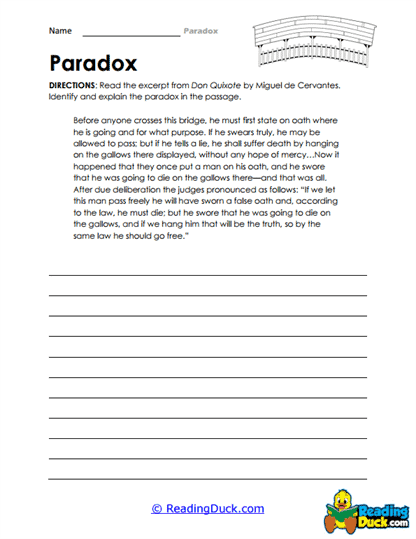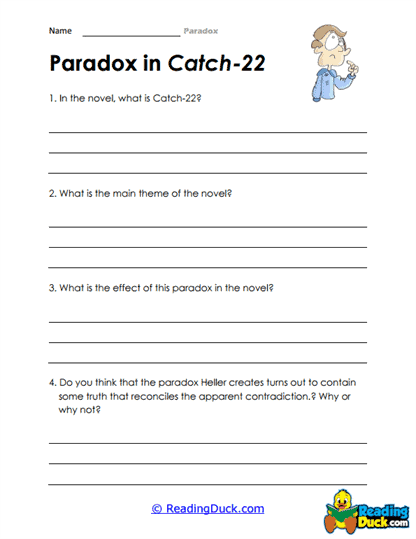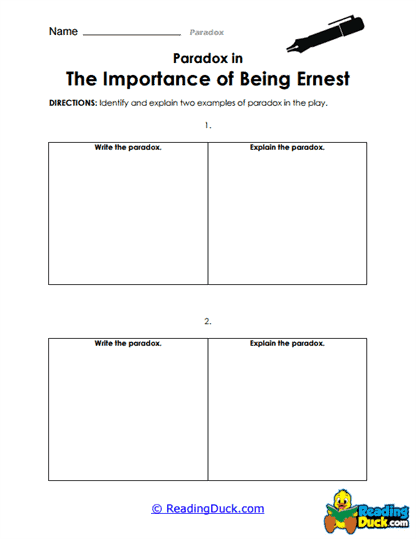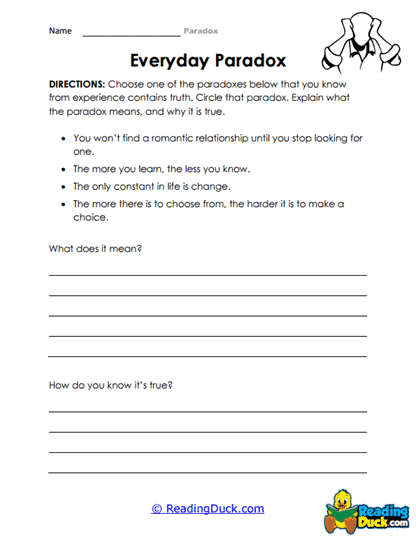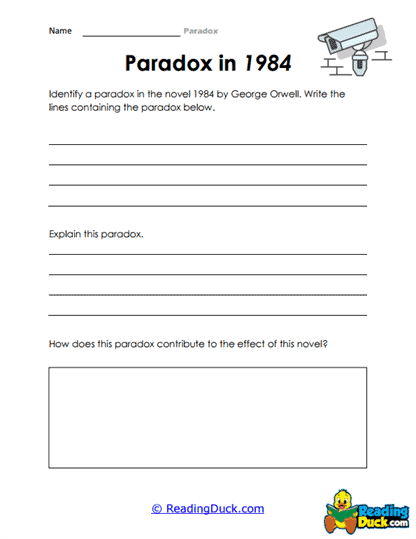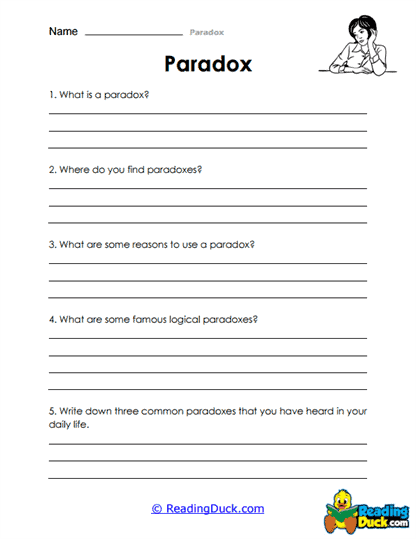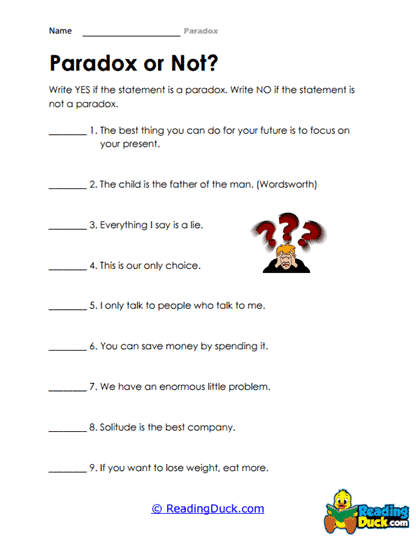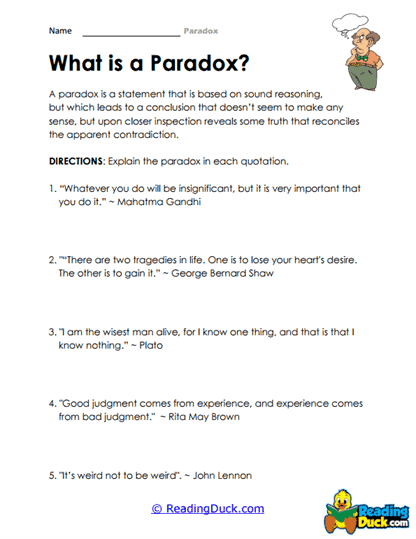Paradox Worksheets
About Our Paradox Worksheets
Our Paradox Worksheets collection, found under the Literary Devices category within the Skills section, is a carefully designed resource to help students grasp and apply the concept of paradox in literature. This collection offers valuable insights into how paradox functions as a literary device, enabling students to explore its role in creating complex meaning, fostering critical thinking, and challenging conventional perspectives.
By working through these worksheets, students will develop the skills to identify, analyze, and interpret paradoxes in various texts, enhancing their understanding of subtle contradictions and deeper meanings within literature. The worksheets are available in a convenient PDF format, making them easy to view, download, and print. Additionally, each worksheet comes with a downloadable answer key, allowing for quick feedback and efficient self-assessment or guided learning.
Understanding Paradox: A Detailed Exploration
A paradox is a statement or situation that appears to contradict itself, yet often contains an underlying truth when examined more deeply. This literary device challenges the reader to think beyond surface-level logic and explore the complexities of language and meaning.
Defining Paradox
- Contradictory Nature: A paradox presents two seemingly opposing ideas or situations. On the surface, these ideas may appear illogical or impossible, but when analyzed closely, they reveal a deeper, often hidden, truth.
- Hidden Truth: The power of a paradox lies in its ability to express a truth that might not be immediately obvious. This hidden truth usually challenges conventional thinking or forces the reader to reconsider established beliefs.
- Provoking Thought: Paradoxes are designed to provoke thought and reflection. Readers must engage with the paradox to uncover its meaning, which fosters critical thinking and deeper literary analysis.
Examples of Paradoxes
- “I must be cruel to be kind”: This famous paradox from Shakespeare’s Hamlet illustrates how cruelty, an act usually associated with harm, can be necessary to bring about kindness or a positive outcome.
- “Less is more”: This common paradox highlights the idea that simplicity or minimalism can lead to greater impact or value, even though “less” and “more” are typically seen as opposites.
- “The beginning of the end”: This phrase suggests that as something begins, it is also moving towards its conclusion, reflecting the cyclical or inevitable nature of events.
Types of Paradoxes
- Verbal Paradox: A verbal paradox involves a statement that contains a contradiction within itself. For example, “This statement is false” is a paradox because if the statement is true, then it must be false, and vice versa.
- Situational Paradox: This type of paradox occurs when a situation leads to an outcome that contradicts what one would normally expect. For instance, a character might seek freedom but end up trapped by their pursuit of it, creating a paradoxical situation.
Characteristics of Paradox as a Literary Device
Paradox has been used by writers for centuries as a way to explore complex ideas, challenge readers, and create rich layers of meaning. Understanding its characteristics helps students appreciate how paradox works in literature and enhances their overall analytical skills.
Key Characteristics of Paradox
- Duality of Meaning: One of the defining features of a paradox is its dual nature—two opposing ideas or statements exist simultaneously. This duality creates tension and invites deeper exploration of the text.
- Thought-Provoking: Paradoxes engage the reader’s mind by challenging logic and forcing a reevaluation of previously held beliefs or assumptions. This intellectual engagement is a hallmark of effective paradoxes in literature.
- Subtlety and Complexity: Paradoxes often require careful interpretation to reveal their deeper meaning. The surface-level contradiction is just the beginning; the true impact of the paradox lies in the complex ideas it represents.
- Philosophical Reflection: Many paradoxes are used to explore philosophical ideas or dilemmas, making them an important tool for examining the human condition, ethics, or existential questions.
Historical Origins of Paradox
Paradox as a literary and rhetorical device dates back to ancient times, particularly in the works of philosophers such as Zeno of Elea, whose paradoxes challenged the nature of time, space, and motion. These early paradoxes were used to stimulate philosophical debates and challenge conventional wisdom.
- Classical Philosophy: Greek philosophers used paradoxes to explore abstract concepts and question perceived realities. Zeno’s famous paradoxes, such as the paradox of Achilles and the tortoise, illustrate how motion and time can be called into question through logical reasoning.
- Religious and Ethical Texts: Paradoxes are often found in religious and ethical literature to challenge believers to think about spiritual truths. For example, the Christian Bible contains paradoxes such as “the first shall be last,” emphasizing humility and service.
- Modern Literature: In contemporary literature, paradoxes continue to serve as a powerful tool for exploring complex themes. Writers like George Orwell and Franz Kafka have employed paradox to critique societal norms and highlight contradictions in modern life.
The Role of Paradox in Building Literacy Skills
Engaging with paradoxes in literature provides young learners with the opportunity to enhance their literacy skills, from critical thinking to reading comprehension. By interpreting paradoxes, students learn to navigate complexity and ambiguity in texts, which strengthens their overall ability to understand and engage with literature.
Literacy Benefits of Studying Paradoxes
- Critical Thinking: Understanding a paradox requires students to think critically and question the apparent contradiction. This practice encourages students to look beyond surface meanings and explore deeper layers of a text.
- Analytical Skills: Analyzing a paradox sharpens a student’s analytical abilities, as they must break down the elements of the paradox, examine how they work together, and determine the underlying truth. These skills are crucial for academic success across disciplines.
- Enhanced Comprehension: By working through paradoxes, students improve their reading comprehension skills. They learn to interpret complex ideas, identify subtle contradictions, and synthesize multiple perspectives within a text.
- Creativity in Writing: When students incorporate paradoxes into their own writing, they learn to play with language and ideas creatively. This ability to express complex thoughts through contradictions helps to develop their voice as writers and makes their work more engaging.
Engaging Activities to Support Paradox Learning
To help students fully grasp the concept of paradox and apply it effectively in their studies, educators can introduce a variety of engaging and interactive activities. These activities are suitable for both classroom and homeschool environments and can be tailored to different grade levels to ensure an appropriate challenge.
Suggested Activities for Paradox Exploration
- Paradox Discussions (Grades 7-10): Organize a class discussion where students explore famous paradoxes from literature and philosophy. Students can take turns explaining a paradox and offering their interpretation of its deeper meaning. This encourages collaborative learning and critical thinking.
- Paradox Writing Challenge (Grades 8-12): Ask students to write their own paradoxical statements or short stories that incorporate a paradox at the heart of the narrative. This activity promotes creativity and helps students apply their understanding of the literary device in a practical way.
- Group Analysis of Paradoxical Texts (Grades 9-12): Divide students into groups and assign each group a literary text that contains a significant paradox. After reading, the group can analyze how the paradox contributes to the themes of the work and present their findings to the class.
- Create a Paradox Poster (Grades 6-8): Have students visually represent a paradox by creating a poster that illustrates the contradictory elements and their deeper connection. This creative activity helps students think critically while also engaging their artistic skills.
- Interactive Paradox Scenarios (Grades 7-9): Develop hypothetical scenarios that involve paradoxical elements. Present these to students and ask them to debate or discuss how the paradox could be resolved or understood. This can lead to lively discussions and deeper exploration of logical contradictions.
The Importance of Paradox in Academic and Personal Development
In conclusion, the study of paradox is a valuable skill that can significantly enhance a student’s academic and personal growth. Paradoxes challenge students to think critically, analyze complex ideas, and develop their interpretive abilities, all of which are essential for success in literature and beyond.
Academically, understanding paradoxes helps students excel in literary analysis, as they learn to unpack subtle contradictions and find hidden meanings within texts. These skills are applicable across a variety of subjects, from philosophy and history to science and ethics, where paradoxical situations often arise.
On a personal level, engaging with paradoxes fosters open-mindedness and intellectual curiosity. As students explore contradictions and conflicting ideas, they learn to embrace ambiguity and uncertainty, which are important qualities for navigating the complexities of life and decision-making.
This collection of Paradox Worksheets equips students with the tools to unlock deeper meanings in literature and develop their critical thinking skills. Through studying paradox, students will not only become more adept readers and writers but also more thoughtful individuals capable of understanding and appreciating the multifaceted nature of the world around them.
